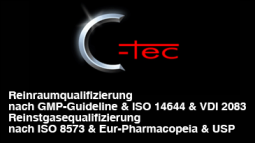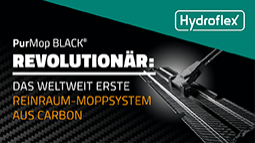Laminar-Flow im Visier
Strömungs-Sensoren für das LF-Monitoring
Ob in der Halbleiterfertigung oder in der Pharmaproduktion, der Anteil der hochklassig reinen oder sterilen Reinräume ist noch immer im Steigen begriffen, weil immer mehr Produktionsprozesse danach rufen. Um den Aufwand für die Erhaltung der Reinheit zu begrenzen ist man dazu übergegangen, nicht mehr den ganzen Raum als hochrein zu deklarieren, sondern spezielle ?Umgebungen? anzulegen, die dann als Mini-Environment, Glovebox, Isolator oder als RABS (Restricted Access Barrier System) bezeichnet werden. Allen diesen Reinräumen gemein ist, dass in einem möglichst kleinen und gegen Zugriffe geschützten Bereich hochsaubere Prozesse stattfinden, zum Beispiel werden flüssige Arzneimittel abgefüllt, oder spezielle Halbleiterprozesse durchgeführt.
Eng verkoppelt mit dieser hohen Reinheit ist der Begriff Laminar-Flow. Darunter versteht man eine turbulenzarme Luftströmung, die sich durch eine sehr geringe Strömungsgeschwindigkeit der Luft auszeichnet. Einer der zu überwachenden Parameter ? vor allem in hochsterilen Abfüllprozessen (sog. Zone A) ? ist dabei die Strömungsgeschwindigkeit der Luft im Bereich des Laminar-Flows. Die von der FDA herausgegebenen Regeln der Good Manufacturing Practices (GMP) legen fest, dass sich die Strömungsgeschwindigkeit in einem Bereich von 0,45 m/s +/? 20% zu bewegen hat. Für Pharma-Reinräume der Zone A verlangen die GMP eine kontinuierliche Überwachung der Strömungsgeschwindigkeit der Luft und hiervon ausgehend hat sich der Begriff vom ?Laminar-Flow-Monitoring? oder kurz LFMonitoring eingebürgert.
Eigentlich ein einfaches Unterfangen, so möchte man denken. Man stellt einen Strömungssensor an einer geeigneten Stelle in der Strömung auf und schließt ihn an das Prozess-Monitoring-System an ? fertig. Dass dem einige Anforderungen der FDA und der Anwender entgegenstehen, das möchte dieser Bericht aufzeigen und gleichzeitig nachweisen, wie ein neuartiger Sensor aus dem Hause Schmidt Technology diesen Anforderungen gerecht wird.
Anforderungen an Strömungs-Sensoren für das LF-Monitoring
Messbereich
Auf Grund des Überwachungsbereiches von 0,36?0,54 m/s hat sich ein Messbereich von 1 m/s quasi als Standard etabliert. Damit sind alle derzeit üblichen Betriebszustände abzudecken.
Messbereichsanfang
Die ISO 14644 legt fest, dass der Messbereich bei 0,1 m/s beginnen muss. Diese Anforderung kommt auch aus dem Anwenderbereich, weil es mittlerweile üblich ist, außerhalb der Produktionszeiten oder während der Desinfektion die Luftumwälzung zu drosseln, was zu Strömungsgeschwindigkeiten um 0,2 m/s führt. Da bekanntermaßen die Messunsicherheit eines Strömungssensors um den Messbereichsanfang besonders hoch ist, gilt die Regel, dass ein Sensor umso besser geeignet ist, je tiefer sein Messbereichsanfang liegt. Die besten Sensoren am Markt liegen heute bei 0,05 m/s. Aus diesem Grunde werden zur LF-Überwachung praktisch nur noch thermische Strömungssensoren eingesetzt. Flügelräder können bei Strömungsgeschwindigkeiten
um oder unter 0,2 m/s nicht mehr eingesetzt werden.
Genauigkeit
Da die GMP eine Strömungstoleranz von +/? 20 % vorgeben bedeutet dies, dass der Sensor in jedem Fall besser sein muss. Das hört sich zunächst einfach an, ist es aber nicht. Da derart kleine Strömungen in Windkanälen nur sehr schwer herzustellen sind muss man bei Strömungen unter 0,5 m/s mit relativ großen Messunsicherheiten leben. Das zeigt sich darin, dass die Sensoranbieter die Messungenauigkeit immer als Kombinationswert angeben z. B. als %-Wert vom Messwert plus einem %-Wert vom Messbereich oder einem Absolutbetrag. Nimmt man zum Beispiel die Angabe einer Messungenauigkeit von 3 % vom Messwert plus einem Festwert von 0,04 m/s, dann bedeutet dies bei einem Messwert von 0,45 m/s eine Messungenauigkeit von 0,0535 m/s und das sind dann schon 11,9 % vom Messwert! Schätzen Sie sich also glücklich, wenn Ihr LF-Sensor bei 0,45 m/s besser ist, als 15 % vom Messwert.
Materialien
Es dürfen nur Materialien eingesetzt werden, die keinerlei Schadstoffe absondern und jeglichen Reinigungs- und Desinfizierprozessen widerstehen. Die Branche vertraut vor allem Edelstahl, Kunststoffe werden nur dann akzeptiert, wenn sie keine Partikel absondern. Für den Einsatz in der Pharmazie wird zusätzlich eine Beständigkeit gegen Alkohole und das häufig eingesetzte Desinfektionsmittel Wasserstoffperoxid verlangt. Kann ein Sensor seine Resistenz gegen die eingesetzten Desinfektionsmittel nicht nachweisen, dann muss er während des Desinfektionsprozesses ausgebaut oder abgedeckt werden.
GMP gerechtes Design
Die Anforderungen an Sterilität erfordern, dass der Sensor eine möglichst glatte und hinterschneidungsfreie Oberfläche besitzt, die problemlos gereinigt werden kann. Versteckte Hohlräume sind zu vermeiden.
Kalibrierzertifikate
Von der FDA akzeptierte Messergebnisse setzen voraus, dass für die Sensoren ein Kalibrierzertifikat vorgelegt wird, das auf nationale Standards rückführbar ist d.h. ein rückführbares Werkskalibrierzertifikat oder ein DKD-Zertifikat sind erforderlich.
Langzeitstabilität
Sensoren für die kontinuierliche Überwachung sollen nach dem Wunsch der Anwender möglichst jahrelang ohne einen Eingriff ihren Dienst tun. Sie werden zwar im 6- bis 12-monatigen Rhythmus durch mobile Messungen überprüft und könnten bei dieser Gelegenheit auch nachjustiert werden. Diese Arbeit ist jedoch vermeidbar, zumal Experten dringend davon abraten, eingebaute Strömungssensoren im Feld abzugleichen. Die Messunsicherheit einer solchen Anordnung ist um Faktoren schlechter als bei einem Abgleich im Windkanal des Sensorherstellers. Folglich sind diejenigen Sensoren klar im Vorteil, deren Messsignal eine möglichst hohe Langzeitstabilität besitzt, so dass keine Nachjustierung vor Ort notwendig ist.
Die Umsetzung der Anforderungen beim neuen Sensor
Der von Schmidt Technology neu auf den Markt gebrachte Strömungssensor zur Laminar-Flow-Überwachung nennt sich SS 20.415 und wurde für den Einsatz in Reinräumen entwickelt. Wie gut dieser Sensor die zuvor gestellten Aufgaben erfüllt, wird im Folgenden überprüft: Der Sensor bietet als Standard einen Messbereich von 1 m/s an, wobei der Sensor bereits ab 0,05 m/s messen kann. Jeder Sensor wird einzeln durch einen Mehrpunkt-Abgleich im hochgenauen Windkanal abgeglichen, daher bietet er eine sehr gute Genauigkeit. Die Messungenauigkeit wird mit 3 % vom Messwert plus 0,04 m/s angegeben. Dies bedeutet bei einem Messwert von 0,45 m/s eine maximale Messungenauigkeit von 0,0535 m/Sek. = 11,9 % vom Messwert.
GMP gerechtes Design: In den Reinraum ragt nur das vollkommen glatte Fühlerrohr (nur 9 mm stark) an dessen vorderem Ende sich das Sensorelement befindet, das geschützt gegen mechanische Belastungen in einem Kammerkopf eingebaut ist. Also nur glatte Oberflächen, ohne versteckte Hohlräume und leicht zu reinigen. Das Fühlerrohr und die Montageteile auf Reinraumseite bestehen aus hochwertigem Edelstahl 1.4571. Nur der sehr kleine Sensorkopf und das darin enthaltene Sensorelement bestehen aus anderen Materialien. Die Beständigkeit gegen Alkohol und H2O2 wurde nach umfangreichen Labortests durch den Hersteller bestätigt.
Jeder Sensor wird auf Wunsch des Kunden mit einem rückführbaren Werks-Kalibrierzertifikat geliefert. Der hochgenaue Windkanal von Schmidt unterliegt der Überwachung eines Qualitätssicherungssystems nach ISO 9001:2000. Der Hersteller bezeichnet diesen Sensor als langzeitstabil (über mehrere Jahre) und hat deshalb keinerlei Abgleichpotentiometer angebracht.
Über diese Eigenschaften hinaus kann der Sensor noch weitere Pluspunkte buchen. Als derzeit einziger LF-Sensor am Markt kann der SS 20.415 die Strömungsrichtung der Luft detektieren und wahlweise auch im Rückwärtsbetrieb messen. Damit ist es möglich, mehrere Filtereinheiten zu überwachen und eine etwaige Rückströmung bei Ausfall eines Lüfters eindeutig zu erkennen. Einmalig ist auch die Verschmutzungserkennung. Kann der Sensor zum Beispiel in Folge einer Reinigungsflüssigkeit auf dem Sensorelement nicht mehr richtig messen, dann gibt er ein Fehlersignal ab. Dieses Fehlersignal verschwindet, sobald der Sensor wieder trocken und damit betriebsbereit ist. Zusätzlich zum Analogausgang verfügt der Sensor über zwei Schaltausgänge, die als Richtungsausgang oder zur Schwellwertüberwachung einsetzbar sind. Da die Ansprechzeit im Bereich von 10 mSek.? 10 Sek. einstellbar ist, können etwaige Turbulenzeffekte beseitigt werden, die auftreten, wenn der Sensor zum Beispiel zu nahe unter Lochblechen montiert wird. Die komplette Elektronik des Messumformers ist im Fühlerrohr eingebaut. Dadurch vereinfachen sich sowohl Ein- als auch Ausbau des Sensors spürbar. Will man den Sensor zur Werkskalibrierung einsenden, dann wird einfach das Fühlerrohr mit der Zentralschraube ausgeschraubt und das Anschlusskabel abgesteckt - mehr nicht.
Besonders stolz ist man bei Schmidt auf das Reinraum-Schnell-Montagesystem. Dieses besteht aus einer Aufnahmemuffe und einer am Sensor angebrachten Zentralschraube. Zuerst wird die Aufnahmemuffe in Wand oder Decke eingelassen, danach das Anschlusskabel installiert, dann wird der Sensor mit dem Kabel verbunden, in die Muffe eingesetzt und mit der Schraube im gewünschten Winkel befestigt. Diese Arbeitsschritte sind in Minuten erledigt. Die Aufnahmemuffe gibt es in 5 verschiedenen Varianten und damit passend zu jedem gängigen Reinraum-Deckensystem. Wird der Sensor in der Decke verankert, dann bietet sich ein um 90 ° gewinkeltes Fühlerrohr an. So ist auf einfache Weise gewährleistet, dass die Fühlerspitze den richtigen Abstand zum Filterauslass und auch zum Rahmen des Filters einhält. In dieser Montageart ist das Fühlerelement auch automatisch richtig zur Luftströmung ausgerichtet und der korrekte Einbau somit ein Kinderspiel. Als zweite Variante gibt es ein gerades Fühlerrohr für den Einbau des Sensors in die Wand.
Fazit
Der Strömungssensor SS 20.415 erfüllt nahezu jeden Anwenderwunsch an einen Strömungssensor zur Laminar-Flow-Überwachung in Reinräumen. Er und weitere Sensoren dieser modernen Baureihe eignen sich bestens für den Einsatz in Reinräumen. Typische Anwendungen sind z. B. die Überwachung der Raumüberströmung, die Volumenstrom-Messung in Zu- und Abluftkanälen oder die Volumenstrom-Messung für Coating- Anlagen.
Artikel Stand 2006

SCHMIDT Technology GmbH
Feldbergstraße 1
78112 St. Georgen / Schwarzwald
Germany
Phone: +49 7724 899198
Fax: +49 7724 899101
email: o.joos@schmidttechnology.de
Internet: http://www.schmidttechnology.de









